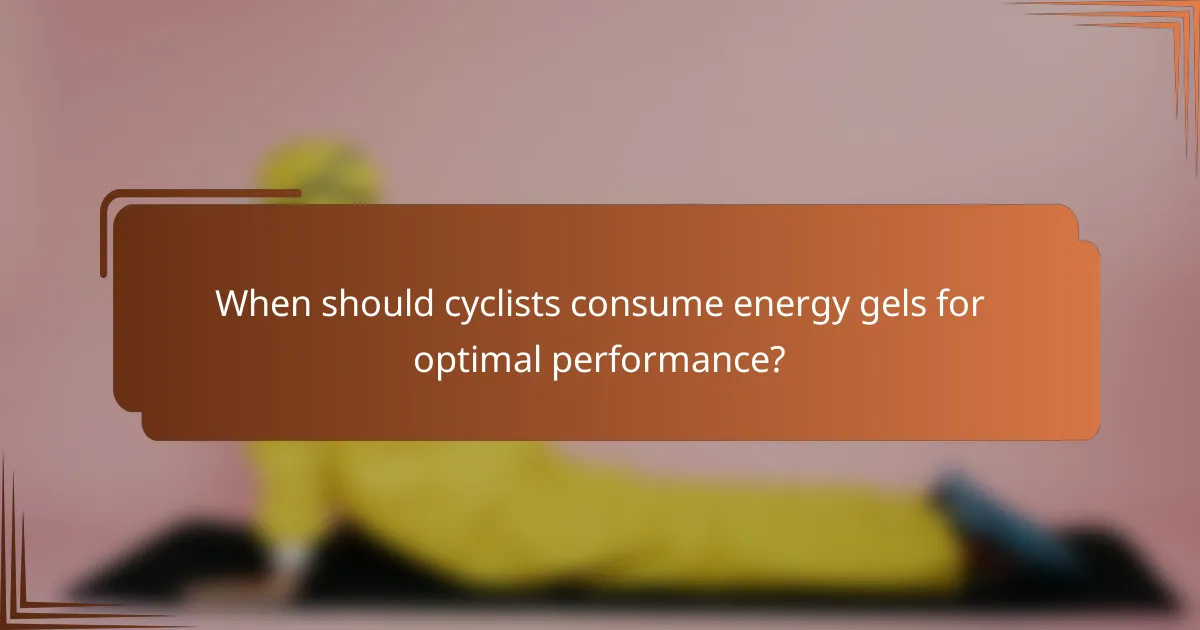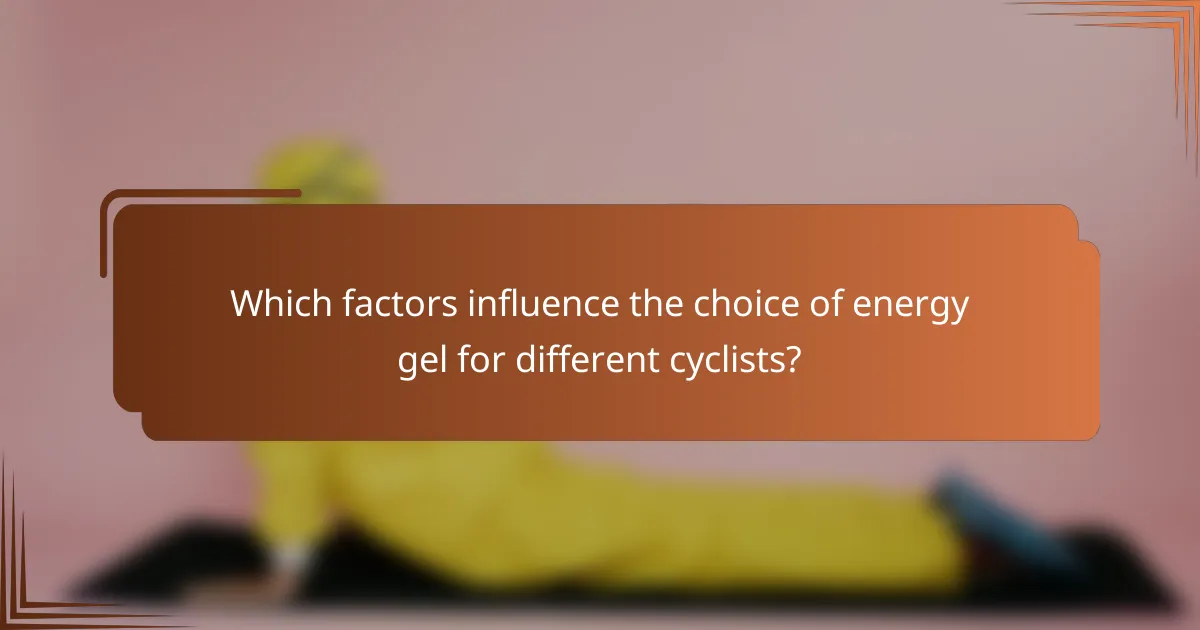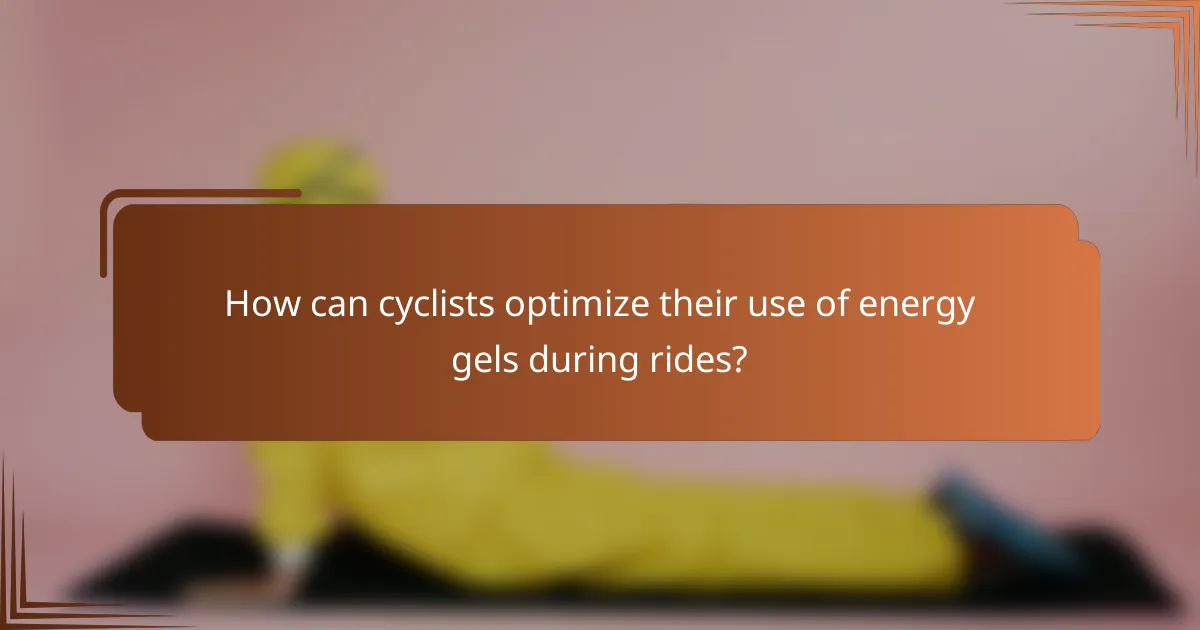Energy gels are essential for maintaining energy and hydration during endurance cycling. This article explores common ingredients like carbohydrates and electrolytes, highlights the benefits of quick energy and improved performance, and discusses optimal usage strategies for effective intake. Additionally, it addresses potential drawbacks and factors influencing gel selection, ensuring cyclists make informed choices for their nutrition needs.

What ingredients are commonly found in energy gels for endurance cycling?
Common ingredients in energy gels for endurance cycling include carbohydrates, electrolytes, amino acids, and flavours. Carbohydrates provide quick energy, while electrolytes help maintain hydration. Amino acids may support muscle recovery. Typical carbohydrate sources are glucose, fructose, and maltodextrin.
How do carbohydrates in energy gels affect performance?
Carbohydrates in energy gels enhance performance by providing a quick source of energy during endurance activities. They rapidly replenish glycogen stores, helping maintain stamina and delay fatigue. The optimal carbohydrate concentration in these gels typically ranges from 6% to 8%, allowing for efficient absorption. Studies show that consuming carbohydrates during prolonged exercise can improve performance by up to 30%.
What role do electrolytes play in energy gels?
Electrolytes in energy gels help maintain hydration and support muscle function during endurance cycling. They prevent cramping and fatigue by balancing fluids and electrolytes lost through sweat. Key electrolytes include sodium, potassium, and magnesium, which are essential for optimal performance. Proper electrolyte levels enhance endurance and recovery, making them crucial for athletes.
Which unique ingredients can enhance energy gel effectiveness?
Unique ingredients that can enhance energy gel effectiveness include caffeine, electrolytes, branched-chain amino acids, and adaptogens. Caffeine boosts endurance and reduces perceived effort. Electrolytes prevent dehydration and muscle cramps. Branched-chain amino acids support muscle recovery. Adaptogens, like rhodiola, improve stamina and reduce fatigue.

What are the key benefits of using energy gels during endurance cycling?
Energy gels provide essential benefits during endurance cycling, including quick energy, improved performance, and enhanced recovery. They typically contain carbohydrates, electrolytes, and sometimes caffeine, allowing for rapid absorption. This combination helps maintain energy levels and prevent fatigue over long rides. Moreover, energy gels are convenient and easy to carry, making them an optimal choice for cyclists.
How do energy gels improve stamina and endurance?
Energy gels improve stamina and endurance by providing quick-digesting carbohydrates, electrolytes, and sometimes caffeine. These ingredients enhance energy levels during prolonged activities, allowing cyclists to sustain performance. For example, a typical energy gel may contain about 20-30 grams of carbohydrates, which can replenish glycogen stores efficiently. Additionally, the inclusion of electrolytes helps maintain hydration and electrolyte balance, crucial for endurance cycling.
Why are energy gels preferred over other forms of nutrition?
Energy gels are preferred over other forms of nutrition due to their quick absorption and convenience. They provide an easily digestible source of carbohydrates, which is essential for maintaining energy levels during endurance cycling. Energy gels typically contain simple sugars, electrolytes, and sometimes caffeine, enhancing performance and hydration. Their portable packaging allows cyclists to consume them on the go, making them a practical choice for long rides.
What psychological benefits do cyclists gain from using energy gels?
Cyclists gain significant psychological benefits from using energy gels, including enhanced focus and reduced fatigue. These gels provide quick energy, which can boost motivation during long rides. Additionally, the convenience of energy gels helps cyclists maintain a positive mindset by minimizing distractions related to food preparation. The psychological comfort derived from knowing they have a reliable energy source can also enhance overall performance.

When should cyclists consume energy gels for optimal performance?
Cyclists should consume energy gels during rides lasting over 90 minutes for optimal performance. Timing is crucial; intake every 30 to 45 minutes helps maintain energy levels.
Energy gels typically contain carbohydrates, electrolytes, and sometimes caffeine, providing quick energy and hydration. Consuming them at the right moment enhances endurance and prevents fatigue. The unique attribute of energy gels is their rapid absorption, delivering a quick energy boost.
For best results, consider individual tolerance and preferences when selecting flavours and formulations.
What timing strategies maximize the effectiveness of energy gels?
To maximize the effectiveness of energy gels, consume them strategically before and during cycling sessions. Taking energy gels 15-30 minutes prior to intense efforts enhances initial energy levels. During prolonged rides, ingest gels every 30-45 minutes to maintain energy and prevent fatigue. This timing aligns with the body’s absorption rates, optimizing performance and endurance.
How does the duration of cycling affect gel consumption rates?
Longer cycling durations increase energy gel consumption rates due to heightened energy demands. Cyclists typically consume gels every 30 to 45 minutes during rides lasting over 90 minutes. This frequency helps maintain stamina and performance. For instance, a cyclist on a four-hour ride may consume four to eight gels, depending on intensity and individual needs. As a result, understanding duration aids in optimizing gel intake for energy management.

Which factors influence the choice of energy gel for different cyclists?
Several factors influence the choice of energy gel for different cyclists, including ingredient composition, taste preferences, and individual energy needs. Cyclists often select gels based on carbohydrate content, which typically ranges from 20 to 30 grams per serving, and the type of sugars used, such as glucose or fructose.
Additionally, the presence of electrolytes and caffeine can affect performance and recovery, making these attributes crucial for endurance cyclists. Some cyclists may prefer gels with natural ingredients or specific dietary considerations, such as vegan options.
Lastly, packaging and ease of use during rides can also play a significant role in selection, as convenience impacts the overall cycling experience.
What are the common dietary preferences affecting energy gel selection?
Common dietary preferences significantly influence energy gel selection, with considerations for ingredients, flavours, and nutritional content. Many cyclists prefer gels that align with their dietary restrictions, such as gluten-free, vegan, or low-sugar options.
Additionally, some athletes prioritize natural ingredients, seeking gels made from organic sources or free from artificial additives. Flavour preferences also play a crucial role; popular choices include fruity, chocolate, or coffee flavours, catering to individual taste profiles.
Moreover, the carbohydrate-to-protein ratio is vital for some cyclists, as they may choose gels that provide a specific balance for sustained energy release. Understanding these dietary preferences helps cyclists select the most suitable energy gels for their endurance needs.
How do individual metabolic rates impact energy gel effectiveness?
Individual metabolic rates significantly influence energy gel effectiveness. Higher metabolic rates may require more frequent intake of energy gels to sustain energy levels during endurance cycling. Factors such as body composition, fitness level, and overall health also play a role in determining how efficiently the body utilizes the carbohydrates and electrolytes found in these gels. For instance, athletes with faster metabolisms may benefit from gels with higher carbohydrate concentrations to meet their energy demands. Conversely, individuals with slower metabolic rates might find lower-calorie options more suitable. Understanding these differences can help cyclists optimize their energy gel usage for peak performance.

What are the potential drawbacks or limitations of energy gels?
Energy gels can cause gastrointestinal discomfort, energy crashes, and may lead to over-reliance during endurance cycling. These drawbacks can affect performance and overall experience.
Gastrointestinal issues stem from high sugar content and additives, which can cause bloating or cramping. Energy crashes may occur if gels are not balanced with proper hydration and nutrition. Over-reliance on gels can diminish the body’s ability to utilize stored energy effectively.
Additionally, some gels contain unique ingredients that may not suit every athlete, leading to rare allergic reactions or sensitivities. Understanding individual tolerance and integrating gels appropriately into a nutrition strategy is crucial for optimal performance.
What common side effects should cyclists be aware of?
Cyclists should be aware of common side effects from energy gels, including gastrointestinal discomfort, headaches, and fluctuations in energy levels. These effects arise from ingredients like high sugar content and caffeine. Monitoring personal tolerance is essential for optimal performance.
How do energy gels compare to solid foods in terms of digestion?
Energy gels digest faster than solid foods, making them ideal for endurance cycling. Gels are designed for quick absorption, providing immediate energy. In contrast, solid foods require more time for digestion, delaying energy release. This rapid digestion of gels helps maintain performance during long rides, particularly when energy demands are high.

How can cyclists optimize their use of energy gels during rides?
Cyclists can optimize energy gel use by timing intake, choosing the right ingredients, and hydrating properly. Consuming gels every 30 to 45 minutes during rides maintains energy levels. Selecting gels with carbohydrates, electrolytes, and minimal artificial additives enhances performance. Hydration is crucial; pairing gels with water aids absorption and prevents gastrointestinal issues.
What best practices should cyclists follow for energy gel intake?
Cyclists should consume energy gels strategically to maximize performance. Start taking gels 30 minutes into a ride, then every 45 minutes to maintain energy levels. Choose gels with a balance of carbohydrates and electrolytes for optimal absorption. Drink water after each gel to aid digestion and prevent dehydration. Avoid trying new brands or flavours during events to prevent gastrointestinal issues.
Which mistakes should be avoided when using energy gels?
Avoiding mistakes when using energy gels is crucial for optimal performance. Common errors include not hydrating adequately, consuming gels too late during rides, and failing to test gels during training. These mistakes can lead to gastrointestinal distress, energy crashes, and reduced endurance. Always ensure you practice with your chosen gels to understand their effects on your body before race day.
How can cyclists tailor energy gel strategies to their personal needs?
Cyclists can tailor energy gel strategies by assessing their unique energy needs, preferences, and hydration levels. Understanding the carbohydrate content, caffeine inclusion, and flavour profiles of various gels can enhance performance.
For optimal usage, cyclists should experiment with different gels during training to identify what works best for their body. Tracking energy levels and digestive comfort can help refine choices. Additionally, considering the timing of intake relative to exercise intensity and duration is essential for maximizing benefits.
Personalizing energy gel strategies can lead to improved endurance and overall cycling experience. Each cyclist’s unique response to ingredients will dictate the most effective approach.